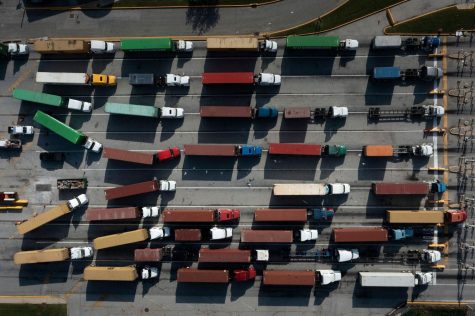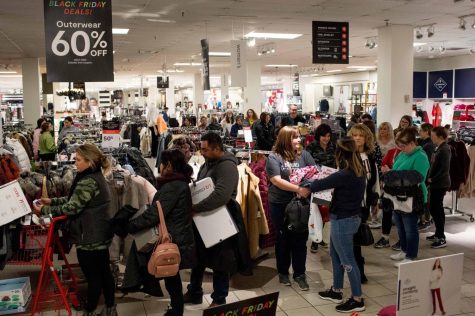Holiday scarcities increase support for small businesses
The effects of the supply chain emergency are reverberating in all aspects of life, even during the holiday season.
Research shows that an increase in consumer demand has incited a supply chain shortage in the global economy that is especially prevalent during the holiday months. A drastic shift in consumer needs, peaking in March 2020, led to widespread scarcities as households worldwide began mass-purchasing items while quarantining, according to npr.org.
As millions of citizens worldwide shifted their workplaces and education to home, demand for manufactured goods skyrocketed, according to sloanreview.mit.org. The production of these wares increased so rapidly that the preexisting gap between supply and demand grew larger. As a result of the coronavirus pandemic, 28 percent of respondents saw shortages of particular household items and had to invent alternate ways to source these commodities, according to zippia.com.
An inability to maintain stability affected the relationship between supply and demand, leading to the current supply chain shortage. The supply chain shortage is now nearing a peak as a result of annual holiday shopping. The holiday season will be an attenuated one as prices will continually rise, cargo loads will increase, and the severity of the situation will only intensify, according to news.northeastern.edu.

The surge in COVID-19 cases decreased the number of workers who were capable of maintaining manufacturing exigency. As workers were falling ill, factories shut down and reduced production. Factories and other companies put these measures into place as a way to uphold public health in the workplace, according to The New York Times. However, the inability to fulfill the demand for essential items has only added to the catapult of manufacturing and retail prices.
Traditionally, large corporations have shipped products overseas in an average of 40 days. The coronavirus pandemic disrupted the order of shipping ports in China that housed boats to transport goods and services across the Atlantic. As a response to mandated shutdowns, the 40 day allocation period is currently subject to an extension of up to 75 days. The dock overcrowding, labor shortages, and the inaccessibility of warehouses all contribute to the obstruction of shipments, according to forbes.com.
The lengthened allocation period described above has only worsened the severity of supply and demand, according to forbes.com. Warehouses report experiencing cardboard shortages, labor shortages, and an increase in gasoline prices, according to businessinsider.com.
Senior Rachel Lherisson reflected on the supply chain crisis as a student in Advanced Placement Macroeconomics, taking a particular interest in its duration and impact on the coronavirus pandemic.
“Even though the height of the pandemic was last year in 2020, the crisis is an ongoing issue that will not likely settle in the future,” Rachel said. “The supply chain needs time to recover which will be difficult in a time where consumers are constantly demanding and businesses are in constant shortage.”
Concerns surrounding holiday retail restrictions contribute to the eradication of small businesses at the hands of larger-scale corporations. The coronavirus pandemic abruptly halted in-person business procedures and many small businesses could not keep up with the online accessibility of bigger companies. However, the current supply chain shortage gives consumers an incentive to support these small businesses. Large firms, such as the Hasbro toy company, have predicted that they will experience the effects of the supply chain shortage in the holiday season. In their most recent quarter, Hasbro squandered over 100 million dollars, according to The Washington Post.

Experts recommend buying from local businesses this holiday season because long-distance shipping is more unreliable and expensive than usual, according to businessinsider.com.
During these unpredictable times, smaller businesses have been in search of alternatives to support their enterprise. Mr. Frank Bittner, the owner of Minuteman Press of Cherry Hill in New Jersey, has made a conscious effort to maximize his supply.
“With the anticipation of limited paper and supply inventories, we have stocked up on as much inventory as we can afford. Limited space in my shop has made this a challenge,” Mr. Bittner said, according to uschamber.com. “We have also tried to make our customers aware of the situation so they are not in shock when their orders take a little longer to complete.”
Smaller-scale enterprises are able to find benefits in the supply chain crisis, as it brings forth new opportunities. Small businesses are able to purchase great quantities of a product from a supplier, a benefit that larger firms do not have.
Mr. Ken Giddon, the owner of Rothman’s, a men’s clothing store in New York, made reference to the advantages his company has experienced as a result of supply chain concerns. He understands that as a smaller company, his counterparts will not be able to fulfill the quantity of stock they need.
“Maybe they have 100 units left of a great sport coat, rather than the 10,000 that a department store was looking for,” Mr. Giddon said, according to marketplace.org. “We may be able to buy that, maybe at a better price.”
Featured Image by Libby Kaseta ’22

Libby is ecstatic to be back in the Newsroom for another engaging school year. She cannot wait to share her passion for journalism with the staff writers...











